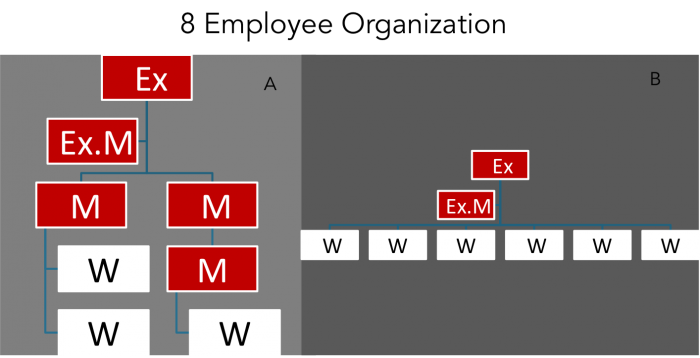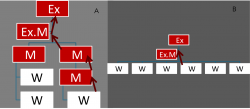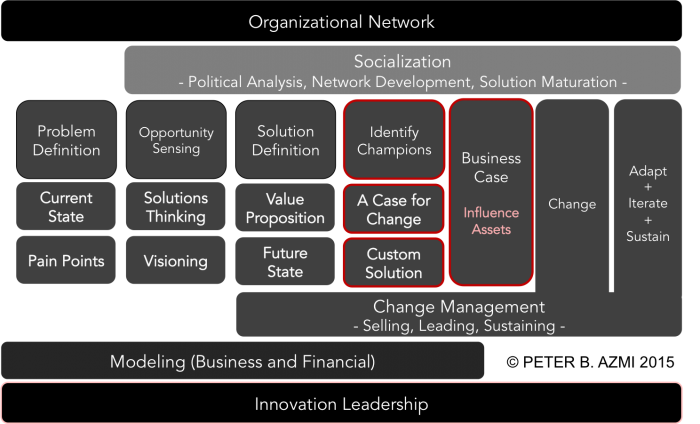“All that is valuable in human society depends upon the opportunity for development accorded to the individual.”
—Albert Einstein
A thought experiment
The Gonzo Innovation framework puts the innovation focus on people, not technologies or inventions.
Put simply, people create technologies and inventions, but unless the creator is innovative or understands how to be innovative, then the creations of the innovator will not have the desired impacts – ie. will likely not be innovative.
The framework can be explained through a the following thought experiment:
- imagine 2 8 person organizations
- org A has 4 managers (M) and 4 workers (W)
- org B has 2 managers and 6 workers

- in this thought experiment, we assume that management does the work of managing workers and workers do the work of an organization (an over simplification, but useful for this thought experiment)
- assuming normal organizational functionality (that is, the organizations are working properly and executing on mission), we ask the following questions:
- which organization has the potential to be more productive? That is, have more output overall?
- which organization has the potential to be more effective at detecting problems when they occur?
- which organization has the potential to be more effective at implementing solutions?
- what differences must exist between these two organizations that would allow for the potential differences in organizational outcomes?
- since workers do work and managers manage and org.B W = 6 and org.A W = 4, we conclude that organization B has the potential to be more productive
- the communication chain in each organization is different.
- problems are generally detected at the worker level but only recognized organizationally when the problem reaches management. Since org.A has 3 or 4 levels of management vs. org.B has only 2 levels of management, we conclude that org.B has the potential to be more effective at detecting problems when they occur.

- likewise, solutions are communicated down from management and implemented by workers. We again conclude that org.B, having fewer layers of management has the potential to be more effective at implementing solutions.

- problems are generally detected at the worker level but only recognized organizationally when the problem reaches management. Since org.A has 3 or 4 levels of management vs. org.B has only 2 levels of management, we conclude that org.B has the potential to be more effective at detecting problems when they occur.
- ∴ org.B has the potential to out-perform org.A, in aspects of productivity and problem solving
- this conclusion can be supported if the assumptions that organization B is functional and is operating to meet it’s stated mission are TRUE
So, what are the functional differences between these organizations that would allow org.B to be more productive and better at solving problems with less than half the number of managers?
ANS: PEOPLE
- if org.A requires 5 managers to be functional and org.B only requires 2, it reasons that the people being managed in each organization are qualitatively different
- for org.B to function well and reach it’s full potential it needs people who:
- require less management and oversight
- have good judgement
- understand the organizational mission and work towards it
- are flexible in roles and responsibilities
- are trustworthy
- have a broad set of skills that likely exceed their counterparts in org.A
- etc.
- these human factors/ traits are critical to org.B’s success and when present, allow org.B to do more, with less management and bureaucracy
- this thought experiment lies at the core of Gonzo Innovation – it illustrates how people, with the right talents and skills, can provide a productive and competitive advantage to an organization
Can people learn to be Gonzo Innovators?
“And let it be noted that there is no more delicate matter to take in hand… than to set up as a leader in the introduction of changes. For he who innovates will have for his enemies all those who are well off under the existing order of things, and only the lukewarm supporters in those who might be better off under the new.”
— Niccolo Machiavelli, The Prince, c1530
- like virtually any skill, the mindset and problem-solving framework of Gonzo Innovation can be learned
- learning the framework helps individuals become better problem solvers and helps organizations become more competitive

- investing in professional skills development leads allows the Gonzo Innovator to solve important challenges which lead to organizational improvements, which in turn develop the reputation of the Gonzo Innovator, which in turn leads to career advancement, which in turn provides greater challenges to grow and hone new skills – this is the Gonzo Innovation Continuous Improvement Cycle
Gonzo Innovation, a Cognitive Framework
Gonzo Innovation, as a concept and cognitive framework is organized into 5 interactive and interdependent layers:
- the foundational layer is “innovation leadership”, which emphasizes the individual Gonzo Innovator. personal qualities of curiosity, creativity, self-awareness, emotional intelligence, team dynamics, and situational awareness are required
- the “modelling” layer focuses on visualization techniques, business analysis, business modelling and financial modelling
- the middle layer is a process of step-wise problem solving, solution proposal and change management. Here, the critical “human factor”, identification of champions, sits at the heart of the framework. Key to this process is the development of influence assets, such as business cases, that can be used to win adoption and drive change
- socialization through networks and an awareness of organizational politics is critical to driving buy-in for new ideas
- the top layer requires the Gonzo Innovator to develop a network of relationships that can be leveraged to help drive new ideas, develop teams, understand stakeholder needs, comprehend political realities and identify champions
